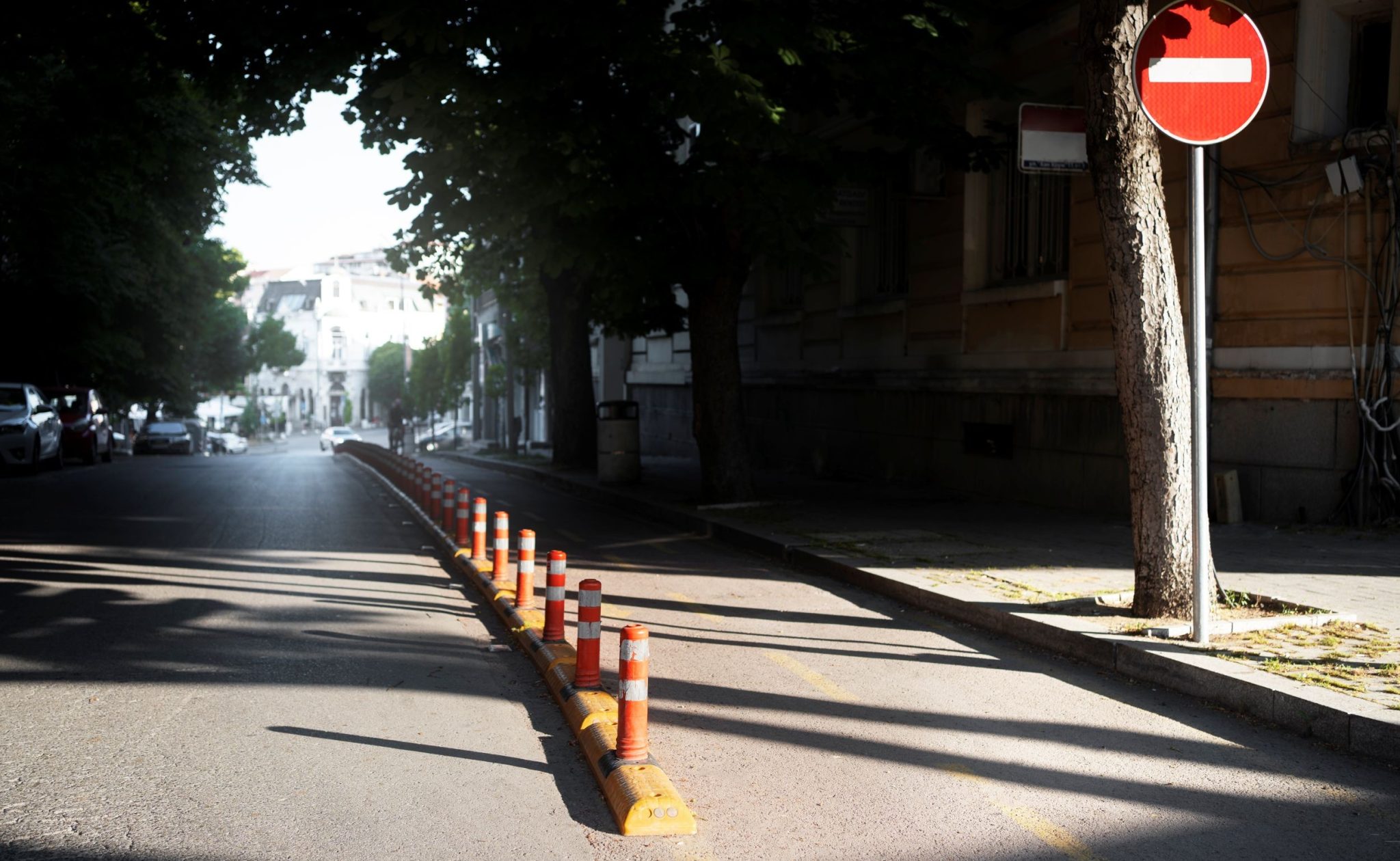Construction work may look temporary, but the reduced numbers on orange-bordered signs are real, enforceable limits. Failing to observe them can double fines, raise insurance rates, and even trigger a short-term licence suspension. This guide explains when are construction zone speed limits enforced, how Ontario sets penalties, and what every driver can do to avoid a costly ticket.
Understanding Construction Zone Speed Limits in Ontario
Many motorists think work-zone limits are only advisory. In fact, construction zone speed limits are prescribed by regulation once the Ministry of Transportation (MTO) or a municipality posts signage. The speed limit in construction zone stretches can be 10–40 km/h lower than the usual limit and applies to every lane between the first orange diamond and the “End Construction” sign.
A second reason these limits matter is evidentiary. Ontario courts have ruled that an orange sign creates a “rebuttable presumption” that the zone was properly designated. In other words, unless a motorist can prove the sign was unauthorized or wrongly located, the reduced limit stands. That presumption shifts the burden onto the defence if a ticket is issued.
Definition and Importance
A construction zone—sometimes called a “work zone”—is any stretch of road or street marked by orange signage, cones, barrels, or temporary concrete barriers indicating roadwork. These zones often feature narrowed lanes, uneven pavement, shifted shoulders, and workers who may stand only centimetres from live traffic. Slower speeds shorten stopping distance and reduce crash forces, protecting both crews and drivers.
Why Speed Limits Are Reduced
The MTO reports that the fatal-injury risk to a roadside worker doubles when a vehicle’s impact speed rises from 50 km/h to 70 km/h. Lower limits also reduce the “shock-wave braking” that triggers rear-end collisions during lane reductions. Projects finish sooner when crashes and near-misses do not halt construction.
Enforcement Rules: When Do Speed Limits Actually Apply?
The moment an orange “Road Work Ahead” sign appears, the reduced limit governs 24 hours a day—whether or not machinery is running. That reality answers the driver’s question: are construction speed limits always enforced? Yes, unless an “End Construction” sign or black-and-white regulatory sign restores the regular speed limit.
As of 2025, every Ontario municipality can create a temporary Community Safety Zone (CSZ) overlay on a work site. A CSZ doubles fines automatically without the “Workers Present” tab.
Active Construction Times
Courts interpret “construction zone” broadly. Workers need not be present and equipment may be parked; if the signs stand, officers or cameras may lay charges at any hour. In busy corridors where contractors work overnight, police often conduct mobile radar patrols between 11 p.m. and 4 a.m., when inattentive motorists become complacent.
Presence of Workers and Signs
Where a “Workers Present—Fines Doubled” tab appears beneath the limit, police can seek the enhanced penalty. If that tab is missing, fines follow the ordinary schedule. Either way, drivers must obey the reduced limit. The MTO’s 2024 sign manual requires that the first numeric sign be placed no more than 150 m after the orange work-zone advance warning. If a numeric sign is absent entirely, that omission may form the basis of a defence.
Use of Cameras and Enforcement Officers
Ontario is supplementing police patrols with Automated speed cameras. Toronto’s Vision Zero program rotates mobile ASE units through active work zones. Each camera photograph records location, speed, and time, and the resulting offence notice is mailed to the registered plate owner. Photo evidence from a speed camera is deemed “prima facie” proof, so drivers must produce credible contrary evidence to be successful in dismissing charges.
Legal Penalties and Fines for Speeding in Construction Zones
Ignoring Ontario’s construction zone speeding laws can be very expensive. Below is the current fine matrix under Provincial Offences Act Schedule 43.
Breakdown of Fines
| Km over limit | Standard Fine (no worker tab) | Worker-Present Fine (double) | Demerit Points |
| 1 – 19 km/h | $2.50 × km | $5.00 × km | 0 – 3 |
| 20 – 29 km/h | $3.75 × km | $7.50 × km | 3 |
| 30 – 49 km/h | $6.00 × km | $12.00 × km | 4 |
| 50 km/h + | Court summons | Court summons | 6 + suspension possible |
Table 1: construction zone speeding fines under Schedule 43.
Demerit Points and Licence Suspension
Demerit points mirror ordinary speeding tickets unless a careless driving charge is added. 9 points can trigger a Ministry interview, which can yield a 30-day suspension. Novice (G1/G2) drivers face escalating sanctions at four points and can lose their licence after a single 30-km/h violation.
Double Fines: When and Why
Legislators doubled fines to deter conduct that puts on-foot workers at direct risk. Section 128(14.1) of the Highway Traffic Act mandates the increase once a zone is properly signed and active. Evidence of workers or operating equipment within 500 m at the time of the offence supports the higher fine. In CSZ overlays, the presence of workers is irrelevant—double fines apply simply because the municipality declared the zone high-risk.
Myths About Construction Zone Speed Enforcement
Misconceptions fuel countless tickets each paving season, so it is worth correcting them. Understanding construction zone speed enforcement Ontario rules can save you hundreds of dollars.
Common Misconceptions
- “I can resume regular speed as soon as I pass the workers.”
False—only an “End Construction” sign or a return-to-normal black-and-white sign ends the zone. - “Police cannot use photo radar in work areas.”
False—ASE cameras are expressly authorized on any municipal or provincial road, including temporary work zones. - “Double fines apply only on 400-series highways.”
False—municipal roads marked with the proper tab or CSZ designation qualify as well.
Clarifications from Ontario Law
Highway Traffic Act s. 128(13) states that construction-zone limits apply “while in a construction zone designated by regulation.” The presence of night lighting, rain, or reduced worker hours makes no difference; the designation controls enforcement.
Tips for Avoiding Tickets in Construction Zones
Receiving fines for speeding in construction zones Ontario is avoidable with a few habits. Being proactive protects lives and keeps your wallet intact.
What to Look Out For
- Advance Warning – Orange diamond “Road Work Ahead” or “Lane Closed” signs appear 300–500 m before the start.
- Regulatory Sign – A black-on-white rectangle displays the temporary numeric limit; the first must appear within 150 m of the orange sign.
- Delimiters – T-cans, cones, or jersey barriers visually narrow the path; assume the reduced limit applies through each barrier taper.
- Electronic Boards – Flashing arrow or chevron boards indicate lane shifts—slow before merging to avoid abrupt braking.
Safe Driving Practices
- Merge early to avoid last-second braking and lane jockeying.
- Keep a three-second following gap; work-zone surfaces can be uneven and tire grip unpredictable.
- Obey flaggers—a hand raised means a full stop, not a creeping roll.
- Use smartphone apps (Google Maps, Waze) that integrate live MTO data on lane closures and speed reductions.
- Turn on headlights in dusk or rainy conditions; visibility drops quickly amid construction dust.
- For professional drivers, activate adaptive cruise only after clearing the zone; the system may not recognize temporary limits.
If you are charged, call Traffic Paralegal Services promptly. Our team can negotiate a lower speed reading, identify signage defects, or argue that the double-fine tab was absent. A disclosure request often reveals whether the numeric sign was placed within the prescribed 150-m distance; if not, the ticket may be withdrawn.
Why Staying Informed Matters
A single conviction for speeding in a construction zone Ontario is classified by most insurers as a “major” infraction, boosting premiums 25–40 % for three years. Collisions inside zones often attract an additional charge, careless driving, that can triple premiums.
Beyond personal cost, slower speeds reduce work-zone injuries by 45 % and motorist injuries by 28 %, according to preliminary 2023 Ontario Road Safety data. Safer zones also mean projects finish sooner, easing congestion and saving taxpayers millions in delay penalties paid to contractors. Communities benefit when rehabilitation work is completed on schedule and emergency-room resources are not tied up by preventable crashes.
Finally, obeying the limit creates a culture of courtesy. Surveyed workers rank “traffic flying by” as their top stressor on the job. A steady flow at 60 km/h rather than 90 km/h lowers noise levels, vibrational hazard, and the mental toll on crews who already face heat, dust, and confined space risks. Driver patience literally improves someone’s workday.
Conclusion
Orange signs are more than construction clutter; they create legally enforceable speed limits backed by strict penalties. Whether enforcement comes from a cruiser or an ASE camera, traffic fines in construction zones are designed to sting. Slow down, scan for signs, and budget extra travel time through work areas. If a ticket does land in your mailbox, Traffic Paralegal Services stands ready to defend your record and your wallet.







Leave A Comment
You must be logged in to post a comment.